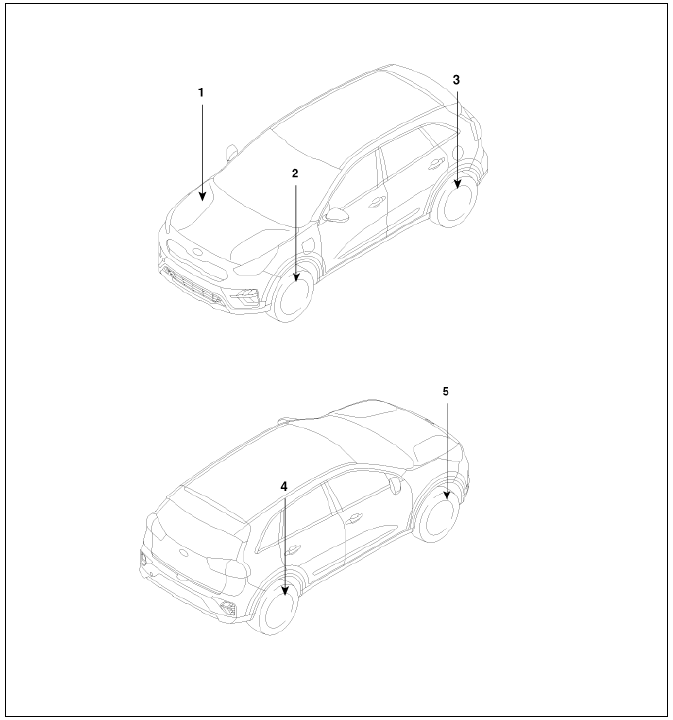KIA Niro: Tire Pressure Monitoring System
Kia Niro - First generation - (DE) (2017-2022) - Service and Repair Manual / Suspension System / Tire Pressure Monitoring System
Tire Pressure Monitoring System / Components And Components Location

- BCM (TPMS)
- TPMS Sensor (FL)
- TPMS Sensor (RL)
- TPMS Sensor (RR)
- TPMS Sensor (FR)
Description
TREAD Lamp
- Tire Under Inflation / Leak Warning.

- Turn on condition
- When tire pressure is below allowed threshold
- When rapid leak is detected by the sensor.
- Indicates that tire needs to be re-inflated to placard pressure / repaired.
- Turn off condition
- Under-inflation: When tire pressure is above warning threshold + hysteresis
- Rapid Leak: When tire pressure is above leak warning threshold
DTC Warning
- Turn on condition
- When the system detects a fault outside the receiver/ sensor
- When the system detects a receiver fault
- When the system detects a sensor fault
- Turn off condition
- If the fault is considered 'critical', then the lamp stays on throughout the current ignition cycle (even if the DTC has been demoted). This is because it is important to bring the problem to the driver's attention. On the following ignition cycle, the demotion conditions will be re-checked. If the demotion conditions occur, the lamp will be turned off. It will stay on until DTC demotion checking is completed.
- 'Non-critical' faults are those that can occur temporarily e.g. vehicle battery under voltage. The lamp is therefore turned off when the DTC demotion condition occurs.
Warning
- When driving in high altitude grades, it is natural for the
atmospheric pressure to decrease.
Therfore, please check the tire pressure and add more air as necessary.
- Tire pressure can be decreased naturally due to decrease in ambient temperature (especially in winter). In this case, fill tires with air to the specification if warning lamp is illuminated as this is natural phenomenon.
System Fault
- General Function
- The system monitors a number of inputs across time in order to determine that a fault exists.
- Faults are prioritized according to the most likely cause.
- Up to 15 faults can be saved.
- Certain faults are not covered through DTC. These include:
- Sensor thermal shutdown (over 257ºF/125ºC).
- Stuck Ignition Line: requires observation of lamps at Ignition ON to diagnose.
- Troubleshooting - Tire Pressure Monitoring System
- TPMS Sensor Repair procedures
- TPMS Receiver Repair procedures
READ NEXT:
 Troubleshooting - Tire Pressure Monitoring System
Troubleshooting - Tire Pressure Monitoring System
TPMS Inspection method
Inspection
Warning
Find the inspection number by referring to the table above.
The following content is irrelevant of the inspection procedure.
Warning lamp types
Stays on without blinking : Low pressure tir
 TPMS Sensor Repair procedures
TPMS Sensor Repair procedures
Removal
Remove the valve core and deflate the tire.
Remove the side of the tire bead area from the wheel using tire changing
machine .
Warning
The tire bead should be broken approx. 90º from the valve side
of the wheel. The be
 TPMS Receiver Repair procedures
TPMS Receiver Repair procedures
Removal
Disconnect the battery negative cable.
Remove the glove box.
(Refer to Body - "Glove Box Housing")
Disconnect the blower motor connector (A).
Disconnect the body control module (BCM) connector (A).
Loos
SEE MORE:
 Hybrid Power Control Unit (HPCU) connector and high voltage cable
Hybrid Power Control Unit (HPCU) connector and high voltage cable
Hybrid Power Control Unit (HPCU) terminal And Input/Output signal
HPCU Terminal Function
Connector (C133-S) (94Pin) : HPCU signal input and control
High Voltage Cable (C133-P) (2 Pin) : HPCU↔Power Relay Assembly
 Unleaded gasoline
Unleaded gasoline
For Europe
For the optimal vehicle performance, we
recommend you to use unleaded gasoline
with an octane rating of RON
(Research Octane Number) 95/AKI (Anti
Knock Index) 91 or higher.
You may use unleaded gasoline with an
octane rating of RO
Categories
- Home
- KIA Niro EV, Hybrid - Second generation - (SG2) (2021-2024) - Owner's manual
- Kia Niro - First generation - (DE) (2017-2022) - Service and Repair Manual
- Contact Us
